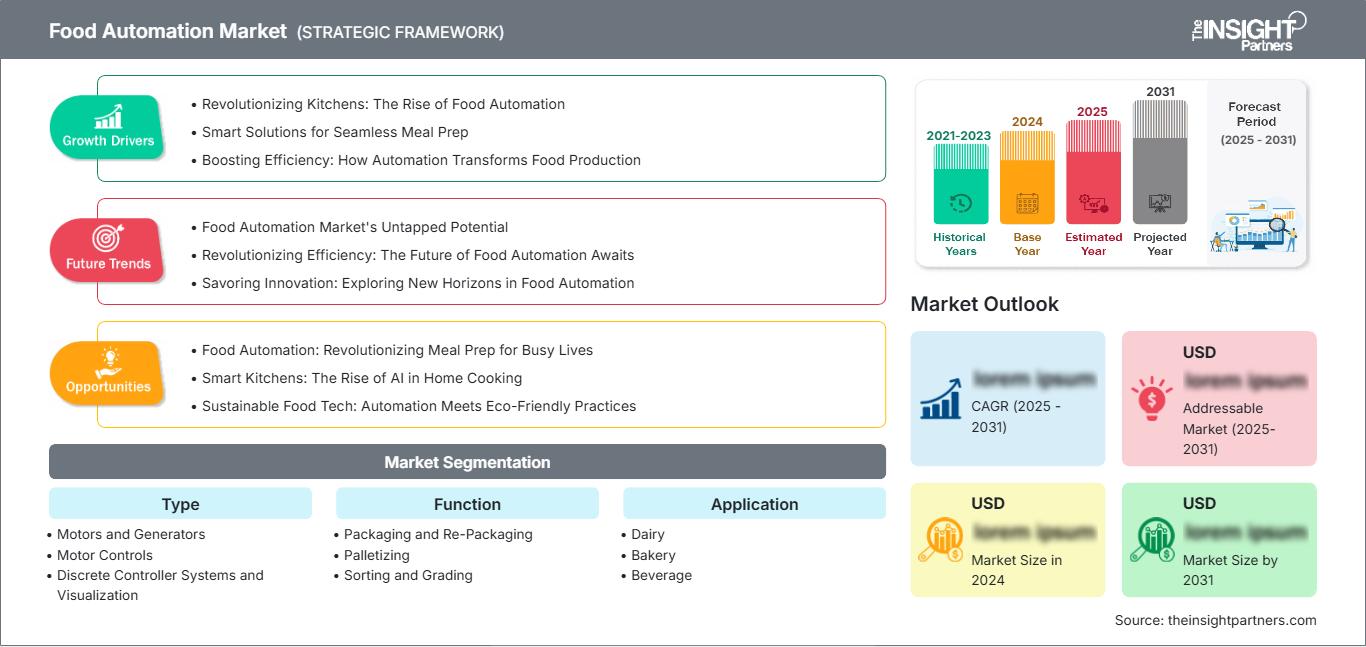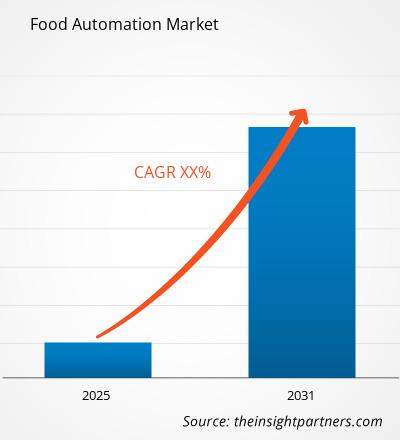预计到2031年,食品行业自动化市场规模将达到185.6亿美元。预计该市场在2025年至2031年期间的复合年增长率将达到9.5%。
本报告按类型(电机和发电机、电机控制、离散控制器系统和可视化、旋转和线性产品)进行分类,并进一步根据功能(包装和重新包装、码垛、分拣和分级、拣选和放置、加工、其他功能)分析市场。此外,报告还按应用(乳制品、烘焙、饮料、糖果、水果和蔬菜、肉类、家禽和海鲜)对市场进行分析。报告对每个关键细分市场在全球、区域和国家层面均提供了全面的细分数据。
报告包含所有细分市场的市场规模和预测,并以美元计价。报告还提供了主要参与者当前市场地位的关键统计数据,以及对当前市场趋势和新兴机遇的深入分析。
报告目的
The Insight Partners发布的《食品自动化市场报告》旨在描述食品自动化市场的现状和未来增长趋势,包括主要驱动因素、挑战和机遇。该报告将为各类商业利益相关者提供参考,例如:
- 技术提供商/制造商:了解不断变化的市场动态和潜在的增长机会,从而能够做出明智的战略决策。
- 投资者:对市场增长率、市场财务预测以及整个价值链中存在的机会进行全面的趋势分析。
- 监管机构:监管市场政策和执法活动,旨在最大限度地减少滥用行为,维护投资者信任和信心,维护市场的诚信和稳定。
食品自动化市场细分类型
- 电机和发电机
- 电机控制
- 离散控制器系统和可视化
- 旋转和直线产品
功能
- 包装和重新包装
- 托盘堆垛
- 分类和分级
- 拣选和放置
- 加工
- 其他功能
应用
- 奶制品
- 面包店
- 饮料
- 糖果
- 水果和蔬菜
- 肉类、家禽和海鲜
您可以免费获得任何报告的定制服务,包括本报告的部分内容、国家/地区层面的分析、Excel 数据包,以及面向初创企业和高校的优惠折扣。
食品自动化市场:战略洞察

- 获取本报告的主要市场趋势。这份免费样品将包含数据分析,内容涵盖市场趋势、估算和预测等。
食品自动化市场增长驱动因素
- 厨房革命:食品自动化的兴起
- 智能解决方案,实现无缝备餐
- 提升效率:自动化如何改变食品生产
食品自动化市场未来趋势
- 食品自动化市场尚未开发的潜力
- 效率革命:食品自动化的未来即将到来
- 品味创新:探索食品自动化领域的新视野
食品自动化市场机遇
- 食品自动化:革新忙碌生活的备餐方式
- 智能厨房:人工智能在家庭烹饪中的崛起
- 可持续食品科技:自动化与环保实践的结合
食品自动化市场区域洞察
The Insight Partners 的分析师对预测期内影响食品自动化市场的区域趋势和因素进行了详尽的阐述。本节还探讨了北美、欧洲、亚太、中东和非洲以及南美和中美洲等地区的食品自动化市场细分和地域分布。
食品自动化市场报告范围
| 报告属性 | 细节 |
|---|---|
| 2024年市场规模 | XX亿美元 |
| 到2031年市场规模 | 191.6亿美元 |
| 全球复合年增长率(2025-2031年) | 8.8% |
| 史料 | 2021-2023 |
| 预测期 | 2025-2031 |
| 涵盖部分 | 按类型
|
| 覆盖地区和国家 | 北美
|
| 市场领导者和主要公司简介 |
|
食品自动化市场参与者密度:了解其对业务动态的影响
食品自动化市场正快速增长,这主要得益于终端用户需求的不断增长,而终端用户需求的增长又源于消费者偏好的转变、技术的进步以及消费者对产品优势认知的提高。随着需求的增长,企业不断拓展产品和服务,持续创新以满足消费者需求,并把握新兴趋势,这些都进一步推动了市场增长。

- 获取食品自动化市场主要参与者概览
主要卖点
- 全面覆盖:该报告全面分析了食品自动化市场的产品、服务、类型和最终用户,提供了一个全面的市场概览。
- 专家分析:该报告是根据行业专家和分析师的深入理解编制的。
- 最新信息:该报告涵盖了最新的信息和数据趋势,确保了其与业务的相关性。
- 定制选项:本报告可根据客户的具体需求进行定制,并能恰当地适应业务战略。
因此,这份食品自动化市场研究报告有助于深入了解和解读行业现状及增长前景。尽管其中可能存在一些合理的担忧,但总体而言,该报告的优势远大于劣势。
- 历史分析(2 年)、基准年、预测(7 年)及复合年增长率
- PEST和SWOT分析
- 市场规模、价值/数量 - 全球、区域、国家
- 行业和竞争格局
- Excel 数据集
近期报告
相关报告
客户评价
购买理由
- 明智的决策
- 了解市场动态
- 竞争分析
- 客户洞察
- 市场预测
- 风险规避
- 战略规划
- 投资论证
- 识别新兴市场
- 优化营销策略
- 提升运营效率
- 顺应监管趋势




















 获取免费样品 - 食品自动化市场
获取免费样品 - 食品自动化市场